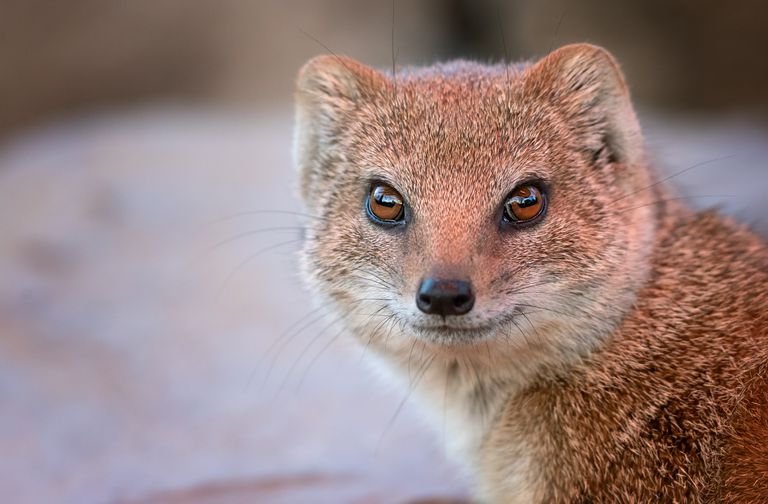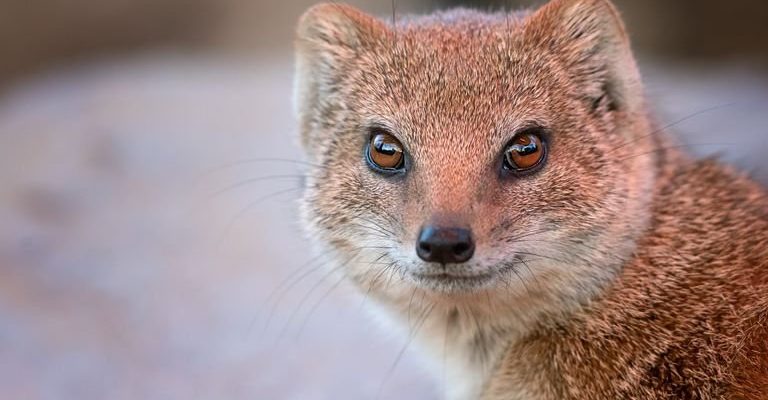
You might be wondering why these fascinating animals deserve your attention. Well, the yellow mongoose isn’t just another cute face in the animal kingdom; it has some extraordinary traits and habits that make it stand out. Let’s dive in and explore the top ten facts that make the yellow mongoose so intriguing!
1. A Unique Member of the Mongoose Family
The yellow mongoose is part of the **Herpestidae** family, which includes other mongooses, such as the famous meerkat. What makes them special? Well, for starters, they’re much smaller than their relatives. Typically weighing between 1.5 to 3.5 pounds, these little guys measure about 19 to 24 inches in length from head to tail. Imagine holding a small cat—this is their size!
These mongooses have a striking golden-yellow coat that helps them blend into their dry, grassy habitats. It’s like nature’s camouflage designed perfectly for the savannas and scrublands of southern Africa. This clever disguise helps them avoid predators while stalking their own prey.
2. Social Structure: A Family Affair
You might think of mongooses as solitary creatures, but here’s the thing: yellow mongooses thrive in social groups. They usually live in **clans** of around 10 to 20 members. These tight-knit families work together, sharing responsibilities like watching for predators while others forage for food. It’s quite heartwarming, almost like a little village of furry friends.
Within these clans, there’s a clear social hierarchy. Usually, you’ll find one dominant pair, and the rest of the group consists of their offspring and other family members. This social structure helps them survive in the wild, allowing them to be alert and work as a team in the face of danger.
3. Eating Habits: Omnivores with a Taste for Insects
What do yellow mongooses eat? Their diet is as varied as their personalities! They’re omnivores, which means they munch on both plants and animals. However, they have a particular fondness for **insects**, small rodents, and even the occasional fruit. Talk about a balanced diet!
Interestingly, they rely mostly on their keen sense of smell to locate food. Picture them darting through the grass, sniffing out a tasty meal. They’re also known to hunt diligently, often digging out burrowing insects to get a snack. It’s a mix of detective work and acrobatic skills!
4. Vocal Communication: Chirps and Chattering
If you ever hear the sounds of a yellow mongoose, you might think they’re having a lively chat! These creatures are quite vocal. They use a series of **chirps**, **chattering**, and even **growls** to communicate with one another. It’s their way of saying, “Hey, watch out for that eagle!” or “Let’s gather and regroup!”
Their calls serve a practical purpose, helping family members stay connected. When they’re foraging or if danger is near, these sounds alert other mongooses, ensuring everyone stays safe. It’s a reminder of how important communication is in the animal kingdom.
5. Adaptations to the Environment
Yellow mongooses have some impressive adaptations that help them thrive in their dry, hot habitats. For instance, their light-colored fur reflects sunlight, keeping them cool during the day. They’re most active in the early morning and late afternoon, avoiding the scorching heat of midday. It’s like they have their own schedule designed around comfort.
Additionally, their long, agile bodies allow them to dart quickly in and out of burrows and dense grass. This agility not only helps them escape predators but also makes them expert hunters. They’re almost like little ninjas of the savanna!
6. The Role of the Tail
Have you ever noticed how animals use their tails? The yellow mongoose has a long, bushy tail that serves multiple purposes. For one, it acts as a balance tool when they’re zipping through their environment. Imagine a tightrope walker using a pole to find their center—this tail does the same for mongooses!
But that’s not all. When they feel threatened, they often raise their tails, letting other members of the clan know it’s time to be on high alert. The tail can also be used in playful interactions among family members, strengthening their bonds. How cute is that?
7. Reproduction and Parenting
When it comes to breeding, yellow mongooses have their own unique practices. Mating occurs during the wet season, and after a gestation period of about 2 to 3 months, the female gives birth to 2 to 5 pups. Just imagine tiny, wiggly balls of fur, eyes closed and ready to explore the world in a matter of weeks!
Once born, the pups are cared for collectively by the clan, not just their parents. This shared parenting practice helps ensure the survival of the young. It’s like having a whole village raise the next generation of mongooses. Isn’t that heartwarming?
8. Predators and Threats
Despite their unique adaptations, yellow mongooses face several threats in the wild. Natural predators include birds of prey like eagles, as well as larger mammals like snakes and jackals. When you think about it, a small creature like the yellow mongoose must always be on its toes!
Human activity poses a significant threat, too. Habitat destruction and hunting have led to declining populations in certain areas. Conservation efforts are essential to ensure that these fascinating animals continue to thrive in their natural environments. Supporting local wildlife initiatives can make a real difference!
9. Local Conservation Efforts
Speaking of conservation, there are various initiatives in southern Africa focusing on protecting wildlife, including the yellow mongoose. Many organizations work tirelessly to educate the public about these creatures and the importance of biodiversity. This is crucial, as every species has its role in the ecosystem!
You might find community programs that involve habitat restoration, anti-poaching measures, and research on mongooses’ behaviors and needs. Getting involved is a fantastic way to help preserve not only the yellow mongoose but the entire ecosystem it inhabits.
10. Fun Myths and Misconceptions
Lastly, let’s address some fun myths! Many people think all mongooses are like the meerkat, standing upright and keeping watch. While yellow mongooses can adopt a similar stance, they spend most of their time on all fours, exploring and foraging for food.
Another common misconception is that mongooses are dangerous or aggressive. In reality, they’re quite shy and prefer to avoid confrontation. They might look fierce with those sharp teeth, but they’re usually more interested in scurrying away than starting a fight.
As we’ve explored, the yellow mongoose is a fascinating little creature packed with surprises. Their social dynamics, playful nature, and adaptations to their environment make them truly unique. So, the next time you hear about the yellow mongoose, you’ll know just how special they are in the grand tapestry of wildlife!

